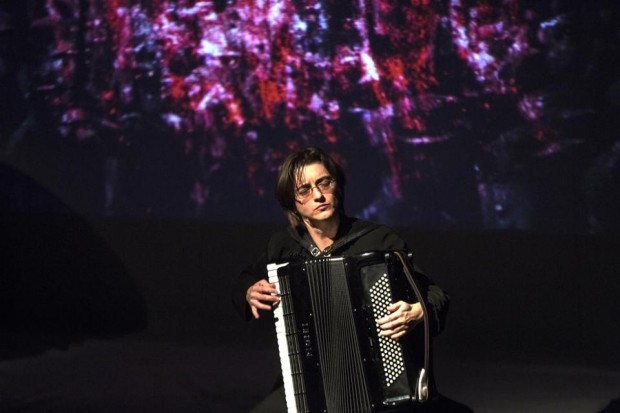
(Photo by Michele McDonald)
Ted Weesner writes about the Boston premiere of Merima Ključo's new work The Sarajevo Haggadah: Music of the Book, and her first encounter with author Geraldine Brooks, whose People of the Book inspired Merima to embark on this musical journey:
To the untrained eye, the Sarajevo Haggadah might seem like something one would pass over on first glance. The cover is battered, the binding beat up; the thing looks like it’s been through the war. In an era when the book as a material object has begun to recede from view, we may well move on to something shinier, more readily accessible: a gently used copy of “The Hunger Games,” perhaps, or a download of the latest, hottest book for our e-reader.
But in passing over the worn, delicate volume, we’d be missing something extraordinary: the opportunity to come face to face with a medieval codex, the calfskin pages of which vibrate like a series of hallucinations, adorned with scenes from the Old Testament and illuminated with copper and gold. It’s the sort of beauty, found in unexpected places and times, that takes your breath away. And while we’re on the subject, it has been through the war. The story of this book inspired Geraldine Brooks, the Pulitzer Prize-winning author, to trace the tortuous and terrifying travels of the Sarajevo Haggadah in her 2008 novel “People of the Book”. Created in Barcelona sometime during the mid-14th century, the Haggadah becomes, in Brooks’s work, the main character in a quest to safeguard and transmit the beautiful and sacred.
And now, with Passover soon upon us, the haggadah — the text recited on the first two nights of the Jewish holiday — is back in the air. Sure, most Seder celebrants will be unboxing the classic utilitarian version first published by Maxwell House Coffee in 1932. But a Bosnian composer and accordionist named Merima Kljuco, inspired by Brooks’s much-loved historical account, has dropped the Sarajevo version back into the art-loving zeitgeist. Her hourlong musical piece, “The Sarajevo Haggadah: Music of the Book,” which includes Kljuco on accordion, Seth Knopp on piano, and video work by Bart Woodstrup, was performed last week under the auspices of the Boston Jewish Music Festival and The New Center for Arts and Culture. The production is now traveling the country.
In 1994, Geraldine Brooks was a correspondent for the Wall Street Journal reporting on the siege of Sarajevo, capital of Bosnia-Herzogovina. The climate of this formerly thriving multi-ethnic city was almost universally grim. She and her compatriot wartime journalists, living in the rather inaptly named Holiday Inn, were encountering one horrifying story after another when something considerably brighter surfaced. The Sarajevo Haggadah, invaluable masterpiece of the Bosnian collections, had been located.
Only later would it emerge that a Muslim librarian, Enver Imamovic, had rescued the codex and deposited it in a Sarajevo bank vault. Seven years later, in 2001, Brooks was on hand, along with many armed guards, when the book was restored in the European Union Bank. As Brooks describes it, the haggadah meant — and means — so much to Sarajevans across ethnicities that, during the siege, she heard stories of natives spending their last coins on replicas of the book, even as they subsisted on grass soup.
At the time, dedicated to her work as a journalist, and soon moving on to cover the strife in Somalia, she filed away the experience. Yet she understood the innate power of the story, sensing how very implausible and incredible it was that the Sarajevo Haggadah had been created in Spain at a time when Jews, Muslims, and Christians coexisted peacefully, even fertilely; how the Inquisition and expulsion of the Jews landed the codex in Venice, where a Catholic priest apparently saved it — his signature is inside the book — from the pope’s book burnings; how it landed in Sarajevo and Vienna in 1894 after a faltering Jewish family was forced to sell it; and finally, how a renowned Muslim scholar, Dervis Korkut, spirited the manuscript out of the National Museum in his waistband under the nose of the Nazis, who had hoped to showcase it in their Museum of an Extinct Race in Prague. The book’s itinerary feels so unlikely that its fate often smacks of fiction — and fiction it became in Brooks’s novel, where facts meld with the creative imagination that grants flesh and bone to people, places, and artifacts alike. As Brooks has come to see it, “The book embodies the story that what unites us is always stronger than what divides us.”
Four years ago, “People of the Book” was pressed upon Merima Kljuco by a determined friend, who thought it brought to mind Kljuco’s difficult journey. “My own Exodus,” as she calls it. When Brooks’s novel fell into her hands, [Merima] felt compelled to make something out of the book. As with Brooks, incandescent art inspired at least an attempt at making more art. In creating the piece, Kljuco called upon the Sephardic traditions of the different countries where the haggadah landed, but also, in the style of Bela Bartok, she added harmonies and clusters to more traditional melodies. The new composition was created in a residency at Yellow Barn, an international center for chamber music in Putney, Vt., with added invaluable support from the pianist Seth Knopp and the video artist Bart Woodstrup.
Kljuco did not meet Brooks until last week when “The Sarajevo Haggadah” was performed for the first time in Boston. And yet having read her novel four years ago, Kljuco was not surprised upon being introduced to the author of “People of the Book” that it felt like a reunion with an old friend.
See a list of all upcoming performances of The Sarajevo Haggadah: Music of the Book
